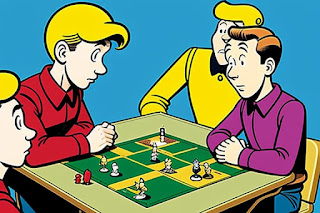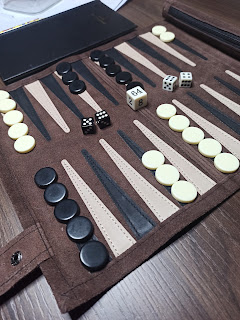I have often explored the field of board games as a cultural and social phenomenon that has gained significant momentum in recent years. The industry has experienced remarkable growth since the late 1990s, although there has been a slight deceleration primarily attributed to increasing logistics costs and global issues such as the COVID-19 pandemic from 2020 to 2023 and regional conflicts such as the situation in Ukraine.
However, propelled by the resurgence of board gaming, largely driven by the significant rise in euro-style or German-style games, many have rekindled their love for the rich complexity of this traditional form of amusement. Board games are analogue cardboard constructs that rest on human intellect to bring life to their rules. The human mind, capable of extrapolating abstractions from intricate, imaginative, or real-life situations, stands as the essential element breathing life into these creations, completing their fundamental nature.
This blog serves as a personal
reflection on the profound impact board games have had on my life, as well as
an exploration of the key elements that I believe significantly influence the
present and potential future of this engaging pastime.
Board games are not developed in
a vacuum. They never materialise outside of a specific context, and I believe
that this context can be coalesced in to three distinct areas of investigation.
These are as follows: -
1. - The Mental Benefits
2. - The Business Aspect, and
3. - The
Social Dimension
These three aspects combined are
what create the entirety or the raison d'être of the board gaming
industry.
I believe that fundamentally when we consider board games, we encounter what can be described as the innate human inclination towards play. Play is a well-documented behaviour in mammals, serving as a tool for learning in young children, cultivating mental abilities, encouraging cooperation and healthy competition, and facilitating socialisation within groups.
Moreover, structured play offers
additional advantages, subtle yet significant, stemming from the engagement of
one's cognitive faculties. I venture to suggest that during structured play,
the brain becomes more active, thereby enhancing its own health and longevity.
Play serves as a mental workout, akin to cardio and weight training for the
body, aiding in the maintenance of cognitive functions over an extended period.
Before I proceed any further, I
would like to offer a definition for structured play and to point out that
within the context of this blog, play and structured play are used
interchangeably to mean the same thing. Structured play, also known as
goal-oriented play, involves using logic to solve problems and following rules or
instructions to reach a particular goal. It is a planned activity that fosters
skills like setting and achieving goals, problem-solving, and active listening.
Recently, I came across a
compelling study that conducted a longitudinal analysis on various individuals,
concluding that engaging in play, specifically board and card games in this
instance, can contribute to maintaining mental acuity for a longer duration.
Engaging in regular play through
board games can enhance critical thinking skills and improve brain
plasticity over time by creating and consolidating neural connections. It also
aids in memory retention for equally evident reasons.
However, we may not always delve
into how this can impact or influence the social dimension inherent in board
gaming. I am referring to the potential of these games to nurture mental
well-being. A healthier, more agile mind stands a better chance of ageing more
gracefully and potentially leading to a more independent and active later life.
Working on neuroplasticity and the formation of new neural connections can also help delay the onset of certain diseases like Alzheimer's. Maintaining a healthy brain means ensuring that old age does not become a significant social burden in the future. While other factors such as genetic predisposition to specific ailments, obesity, and adverse environmental conditions can undermine these efforts, the adage "healthy mind in a healthy body" should remain our guiding principle in our pursuit of more dynamic and independent golden years.
Let us now shift our focus to
another crucial aspect of board gaming: the social dimension. The way societies
embrace or reject gaming in adulthood varies from country to country. You will
find nations with a history of acceptance when it comes to games like
Backgammon. To this day, for instance, Turkey, Greece, and Israel are three
territories known to embrace backgammon as part of their cultural heritage.
Chess, on the other hand, is particularly popular in Russia, the United States,
and China. This does not imply that these games do not enjoy a healthy
following in other countries; rather, it suggests that certain nations have
populations that are more receptive to these games.
Additionally, there is the matter
of what may be perceived as fashionable within a social context. Most popular
games go through cycles of popularity during which they are embraced by society
and the media in general. While the demographics must be present initially,
having a particular game portrayed in popular media tends to increase that
game's appeal within society at large.
As an illustration, I would like
to highlight the Dungeons & Dragons roleplaying system and board games in a
broader sense. Popular television shows like The Big Bang Theory and Stranger
Things have reintroduced the concept of playing Dungeons and Dragons.
Individuals who grew up in the eighties witnessed a transformation where a once
marginalised and stigmatised gaming system regained popularity. Playing
Dungeons and Dragons once again became trendy.
This resurgence sparked a
significant revival of the gaming system and, consequently, all board games and
gaming literature associated with it. Moreover, ardent fans of the genre, who
were previously discreet about their passion, now prominent figures in
contemporary cinema, openly expressed their long-standing love for and
engagement with Dungeons and Dragons since their youth. Such endorsements
further fuelled enthusiasm among fans to explore what Gary Gygax had envisioned
in the seventies.
Similarly, the sitcom The Big
Bang Theory also brought board games back into the mainstream media. Audiences
observed the actors playing modern classics like Ticket to Ride and Catan,
often with a comedic twist, signalling a widespread acceptance of board games.
On a societal level, board games
possess the remarkable ability to bridge generational divides and mitigate
age-related biases that are prevalent in other social settings. For these and
various other reasons, board games serve as excellent icebreakers, fostering
the establishment of new friendships. By breaking down artificial barriers
associated with age, they also contribute to promoting active aging in general.
While it is worthy to positively
appraise the benefits of board gaming, there is one dimension that, while not
strictly about board games, requires our attention and that is the business
aspect, the proverbial elephant in the room.
As I stated earlier, board games are not created in a vacuum. They are the deliberate physical manifestation of a business venture focused on producing products that people desire with the goal of generating profits. If a game does not sell, it will not be produced; this is a straightforward concept to grasp. In the current market, where there is an appetite for quality games, businesses have proliferated like weeds in a race for potential buyers' money.
I am convinced that each board gaming
company meticulously analyses sales figures, striving to maximise profits while
minimising costs when it comes to sourcing raw materials, artwork, and
manufacturing the products. In this case, the products are the game boxes
themselves.
Admittedly, this philosophy does
not always result in high-quality products. A board game company may choose to
embrace sustainability and eco-friendliness in their design and manufacturing
process, but they cannot do so at the expense of quality. With the vast array
of new board game titles hitting the shelves each year, companies cannot afford
to make mistakes.
While games like Wingspan can make a significant impact on the board gaming community, there are numerous unsuccessful attempts that never gain traction. A brilliant concept on paper may not always translate into a successful product in the global markets. Therefore, when a company achieves success, their primary goal is to ensure the enduring popularity of their products. Essentially, they must come up with ways to prevent the game from fading into obscurity, overshadowed by the pursuit of the next trend or fashionable game.
Unfortunately, definitive answers
to this challenge are not readily available; otherwise, we would be inundated
with exceptional new games throughout the year. Nevertheless, it is evident
that designers have tried everything to garner the attention of gamers, from
compact titles with streamlined components to expansive multi-box creations
that require a cart for transportation. While innovation is abundant, there are
instances where designers prioritise glamour and extravagance over quality and
the long-term viability of their products.
The truth is that if you do not
prioritise longevity for your latest game creation, you will not bother with
those details. However, from a personal perspective, it is difficult to imagine
dedicating enough playtime to justify spending €200 upfront on a massive game
with multiple expansions. The alternative, a more contained price tag on a core
game with subsequent “expansions” hitting the market later (spread out over
time) could be considered more acceptable to the consumer. It could also work
miracles in ensuring the longevity of a gaming product.
As businesses strive to produce
high-quality titles, they must consider other aspects when embarking on their
next project. They need to understand that players interested in their games
are seeking something novel, the excitement of discovering an exceptional new
game. This means that businesses must invest in design, creativity, and, most
importantly, innovation.
Simultaneously, these board
gaming companies must ensure that their costs are contained, that the
coordination required to deliver the end product to customers is reasonably
priced, and that none of these factors will compromise the longevity of their
product. They must accomplish all this while adopting a sustainable business
mindset when sourcing raw materials, managing social stigmas that may exist in
target markets, and addressing what could be considered acceptable.
This is the reality we face in 2024. We are witnessing diverse competing factors shaping the way we perceive and consume board games, while simultaneously being aware that these same games could prove beneficial on a societal level by nurturing mental health. As we promote these board games for all the potential benefits they offer, we necessarily require access to businesses that understand the market and the globalised world in which we live.
This industry attracts a diverse
array of individuals, from business professionals and art designers to
professors with a talent for converting numbers into games. This hobby
transforms some into collectors, others into gamers, or both. Yet everyone
involved in this industry is drawn to it by a common denominator: an appetite
for play and the desire to tackle the next challenge.
In conclusion, as a hobbyist who
is both a gamer and a collector of board games, I feel that the evolving
landscape of board gaming offers valuable insights and experiences that have
enriched my personal journey as I proceed through life.
From the mental benefits
perspective, engaging in board games not only provides me with entertainment
but also nurtures critical thinking skills, enhances my brain plasticity, and will
hopefully aid in my memory retention. I look at these games as a platform for
continuous learning, problem-solving, and cognitive stimulation, contributing
to my mental well-being and cognitive longevity.
I have also grown to appreciate
that from a social perspective, board gaming serves as a powerful tool for
bridging generational gaps, fostering friendships, and combating ageism.
Through board games, I feel that I constantly learn valuable life lessons in
collaboration, communication, sportsmanship, and adaptability. The socialisation
component of board gaming encourages teamwork, empathy, and social interaction,
enriching my social experiences as I walk through life.
In essence, the amalgamation of mental benefits, the social dimension, as well as the business aspect offer insights into this holistic journey that not only entertains but also educates, and challenges, while allowing me to connect with others. I think that embracing these facets of board gaming can offer you a well-rounded perspective on life, teaching you resilience, creativity, and the importance of human connection in your personal growth and interactions with the world around you.
Embracing and sharing these
values is what has kept me captivated by board games for so long. These games
are not merely about play; if you delve deeper, you will arrive at the realisation
that they are fundamentally about two things, communication and understanding.
When we share common goals, follow similar rules, and engage meaningfully with
others, we might discover that what divides us is not so much our differences,
but rather a lack of empathy and a willingness to communicate unhindered by
biases or misconceptions. Learning to overcome human limitations through
communication can never be a detrimental pursuit, and I believe that if
everyone followed the underlying philosophies that epitomise board gaming, the
world would be a much better place.

.jpeg)


.jpeg)
.jpeg)
.jpeg)
.jpeg)
.jpeg)
.jpeg)
.webp)
.jpeg)














